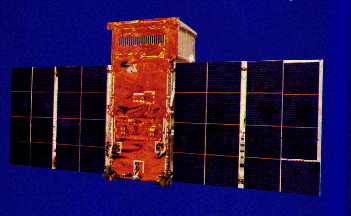
The Thor-Delta rocket system became known as the TD satellites. TD-1A was
successfully launched on 11 March 1972 from Vandenberg Air Force Base (12
March in Europe). It was put in a nearly circular polar sun-synchronous orbit,
with apogee 545 km, perogee 533 km, and inclination 97.6 degrees. It was
Europe's first 3-axis stabilized satellite, with one axis
pointing to the Sun to within +/- 5 degrees. The optical axis was maintained
perpendicular to the solar pointing axis and to the orbital plane. It scanned
the entire celestial sphere every 6 months, with a great circle being scanned
every satellite revolution. After about 2 months of operation, both of the
satellite's tape recorders failed. A network of ground stations was put
together so that real-time telemetry from the satellite was recorded for
about 60% of the time. After 6 months in orbit, the satellite entered a period
of regular eclipses as the satellite passed behind the Earth -- cutting off
sunlight to the solar panels. The satellite was put into hibernation for 4
months, until the eclipse period passed, after which systems were turned
back on and another 6 months of observations were made. TD-1A was primarily a
UV mission however it carried both a cosmic X-ray and a gamma-ray
detector.
The X-ray detector was a 100 sq-cm proportional counter covering the energy
range 3-30 keV. When switched on, the experiment caused abnormal readouts
in the satellite's telemetry. Alas, it was switched off and remained that
way.
Also on board was a small spark chamber experiment called MIMOSA for
observations of gamma-rays from 70-300 MeV. The instrument was equipped with a
stereoscopic TV system viewing through the chamber portholes to record the
particle tracks. It operated from March-October 1972. There was a
significant particle-induced background, despite an anti-coincidence
system. Numerous gamma-rays were detected, but no gamma-ray point sources
could be identified.
There were two stellar ultraviolet experiments on board. The Utrecht
Orbiting Ultraviolet Stellar Spectrometer S59 used a small telescope
and a three-slit scanner covering three bands between approximately
2100 and 2800 Å. About 200 bright stars were observed by the
instrument and were later published in a catalog. The S2/68
spectrophotometric sky survey telescope was developed jointly by the
UK and Belgium. It operated in the range 1350 and 2550 Å. This
experiment used an off-axis reflecting telescope to focus radiation
onto a set of entrance slits. These in turn fed a photometer and a
three-channel spectrophotometer. The light falling on the
spectrophotometer entrance slit was reflected onto a diffraction
grating, and the dispersed light then passed through one of three
slits and then onto individual photomultipliers. The orbital motion of
the satellite caused the dispersed beam to scan across the exit slits.